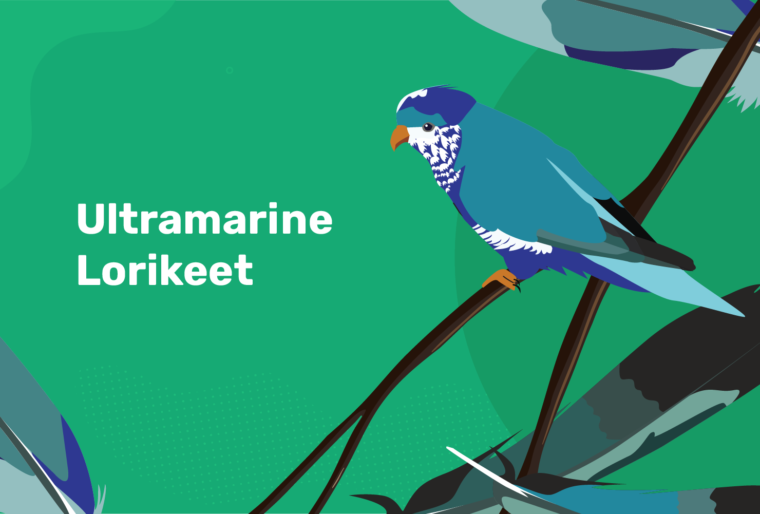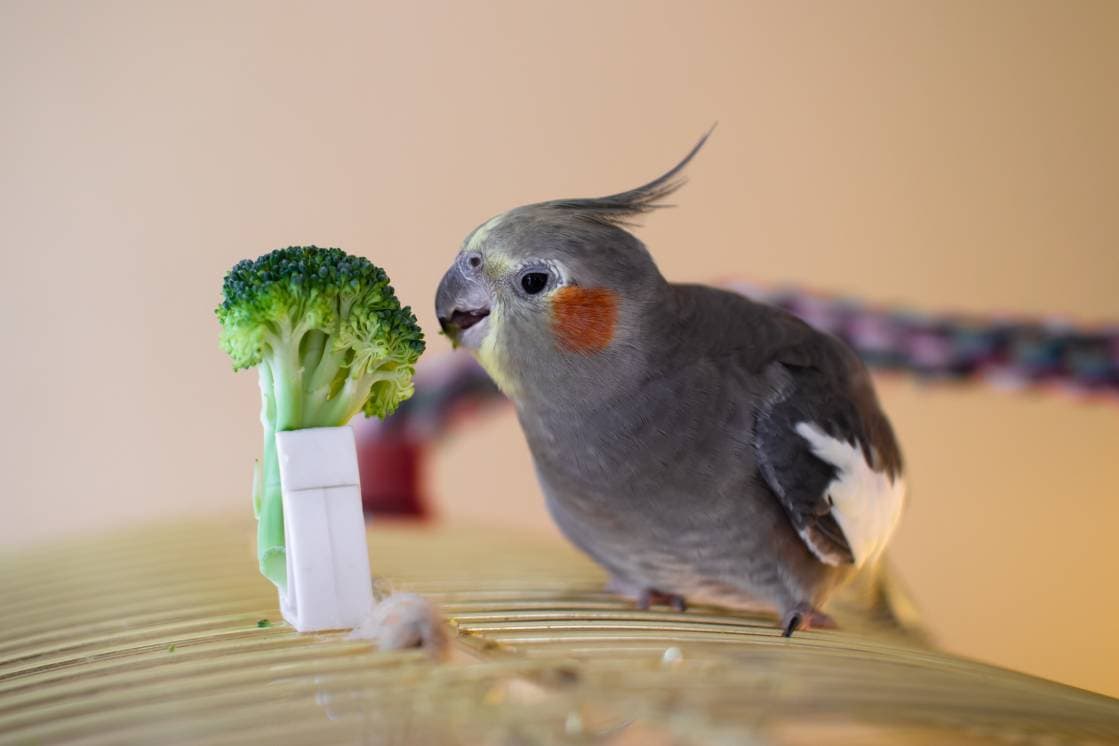
The Ultramarine Lorikeet is endemic to the Marquesas Islands, which are located in the southern Pacific Ocean. They inhabit tropical, moist habitats for the most part, though they can also be found on plantations and similar areas.
They are critically endangered due to their small range and deforestation. Introduced predators, like the black rat, also threaten their population.
This species is not well-known in captivity. Their rarity in the wild carries over to captivity, making them extremely difficult to find.
However, they can be kept as pets, and their care is similar to that of other Lorikeets.
Keep reading to discover if this bird is the correct species for you.
Species Overview
| Common Name: | Ultramarine Lorikeet |
| Scientific Name: | Vini ultramarina |
| Adult Size: | 7 inches |
| Life Expectancy: | 20–30 years (tentatively) |
Origin and History
The Ultramarine Lorikeet has been in a slow decline since the 1970s.
At this point, the bird was present on many different islands, including Fatu Kiva, Ua Pou, Nuku Hiva, and Ua Hiva, all places that the bird was initially native to.
However, many of these islands experienced heavy deforestation. Without the trees, this bird was unable to adapt and slowly became endangered.
The introduction of the invasive black rat and domestic cat also led to decreases in their overall population. These predators kill huge numbers of birds each year.
By 2008, the bird was extinct on many of their native islands. Today, their only wild population is on Ua Huku. Here, their population is estimated only to be about 1,500 individuals.
They do not have a significant captive population either.
Due to their rarity, some conservation steps have been taken. However, there is no large-scale breeding program or similar conservation efforts.
Temperament
Not much is known about the Ultramarine Lorikeet due to their rarity. They are not widespread in the wild or captivity, so few people have had the chance to interact with them.
The little information that we do have shows that they are affectionate little birds. They may take well to captivity and humans for this reason. (That said, we don’t know this for sure.)
They will likely be similar to other Lorikeets. We expect that they are easy to socialize and tame. They are social animals, so regular interactions with their owners will be required.
This species may be territorial, especially during the breeding season. On the other hand, they may be suitable for living with others. It may depend on the bird.
We don’t know much about their behavior in the wild, which makes their captive behavior nearly impossible to determine.
You may want to consider adopting multiple birds if you can find them. However, due to their endangered nature, we don’t recommend keeping them with other Lorikeet species. They may get along with them just fine, but interbreeding could result in their population declining even further.
Most captive breeders are primarily focused on keeping this species around. Therefore, these aren’t traditional pet birds. The emphasis while breeding is usually based around survival, not taming. Therefore, this species likely won’t be as friendly as the Rainbow Lorikeet, for example.
They aren’t usually hand-raised or socialized heavily. These practices can stress out the bird and make them less likely to survive.
Speech & Vocalizations
Like many Lorikeets, the Ultramarine is thought to be quite vocal. Of course, we don’t know exactly how they compare to their cousins.
Most Lorikeet species can learn to talk and are relatively intelligent. We expect that this Lorikeet species possesses similar skills.
Significantly few people have interacted with them enough to know, though. When there are fewer than 2,000 individuals overall, it can be challenging to find one to talk to.
They are loud in the wild, though. This loudness probably won’t change in captivity. Therefore, they aren’t suitable for those living in apartments. If you’re looking for a quieter bird, this is not the best option.
Ultramarine Lorikeet Colors and Markings
The Ultramarine Lorikeet developed entirely in the wild, unlike some other bird species. Therefore, they don’t have many color variations.
Both sexes look nearly identical, though the female is a bit smaller. Their legs and beak are bright orange, while their head is light blue. They have blue and white markings on their cheeks and throat. Their back wings are varying shades of blue.
They are incredibly colorful birds. It is surprising that they aren’t more popular.
They may have the genetic capability of producing other colors and markings. However, we don’t know if this is the case. They have not been bred extensively enough in captivity for differences to be observed.
More color variations may become apparent in the future.
Caring for the Ultramarine Lorikeet
Few people have taken care of this bird in captivity. They are extremely rare in the wild and as pets. Therefore, care information is challenging to come by.
If you adopt one, we recommend speaking to the previous owner. They will likely have the most information about caring for these rare birds.
That said, their care is likely to be similar to that of other Lorikeets.
They will probably require a large cage that is at least 4 ft x 2 ft x 3 ft. This species is quite active, despite their smaller size.
Aim for a metal cage, as they are naturally adept at tearing up wood.
Due to their nectar-based diet, they can be messy. Plan on spending a great deal of time cleaning their cage, and don’t be surprised if they get the area around the cage messy as well. The walls and floor around their cage should be wiped down regularly, as they will get nectar everywhere.
You can likely potty-train this species to help control some of the mess that way. However, this won’t help with the mess that they make while eating.
The sugary nectars that they eat are prone to bacteria growth. All food dishes should be cleaned often. Don’t leave their food out for more than 2 hours at a time, or it may get contaminated.
This species is rather intelligent. Prepare to offer plenty of toys for entertainment purposes. You need to keep their minds busy, or they can become destructive.
Socialization is also required. Expect to spend a few hours every day with your bird. This heavy socialization can also help with stress-induced behaviors.
Common Health Problems
The health status of this species is difficult to determine. They may be less healthy than other species due to their smaller gene pool, but nothing is known for sure.
They may be prone to Lorikeet paralysis syndrome. This condition is severe and prevents the bird from moving. They will lose their ability to swallow or drink.
Most birds will not recover from this condition. The exact cause is unknown, but there is no sign that it is infectious. A vitamin deficiency may play a part, as could dehydration.
Some birds can recover with pain medication, care, and nutrition. They may regain their ability to fly over several months.
Like all intelligent bird species, the Ultramarine Lorikeet may begin feather plucking. Usually, this occurs when they are bored or stressed. Prepare to entertain your bird and socialize with them daily.
If your bird begins picking at their wings, it is usually a sign that they are not being cared for properly.
Sour crop can affect some birds. This condition is caused by a bacterial infection of the bird’s crop. Usually, cleaning the cage properly helps prevent this condition, as it occurs most frequently due to infected food.
Diet and Nutrition
Lorikeets have unique dietary needs, including the Ultramarine Lorikeet.
In the wild, they live primarily off a diet of pollen, flowers, and nectar. They collect these foods from many different trees. However, they seem to prefer the coconut palm and sea hibiscus.
They may also eat fruits and insects, though these will make up a tiny part of their diet.
In captivity, feeding them can be a bit complex. They don’t eat seeds or pellets like other birds. Instead, they will need to be fed commercial or hand-mixed nectar.
These birds eat for extended periods in the wild. However, it is important not to overfeed them because they can become overweight. This can cause various health problems.
You can supplement their diet with fresh fruit and organic flowers. These should be supplements, though, not significant portions of their diet. Citrus fruit should be avoided, as it can affect their digestion.
While we don’t have much information about the Ultramarine’s diet in captivity, they are likely allergic to the same foodstuffs that other birds are. These include avocado, coffee, rhubarb, alcohol, and chocolate.
Exercise
Not much is known about the Ultramarine’s exercise needs. However, it is expected that they are active birds, like other Lorikeets.
We recommend exercising them extensively. Usually, this means letting them out of their cage for 3-4 hours a day. You will need to supervise this time, and it should preferably be split into multiple sessions.
They are intelligent birds, so they require many toys. These will help keep their minds and their bodies busy. We recommend regularly switching out the toys in their cage, as they can get bored otherwise.
Where to Adopt or Buy an Ultramarine Lorikeet
These birds are nearly impossible to find in captivity. There are few breeders, and they are not active at all times.
It is also illegal to import these birds because they are endangered.
These two factors make them nearly impossible to find in captivity. While they may make good pets, most people will not have the chance to adopt one. Unless you know a breeder personally, the odds of finding someone are slim to none.
Therefore, we recommend that most potential buyers look at other Lorikeet species. Many others are readily available in captivity.
Final Thoughts
The Ultramarine Lorikeet is not commonly kept as a pet. They are rare in captivity and the wild, making them nearly impossible to find in most cases.
Their rarity also means that little information is known about them. There aren’t many individuals around to study.
We expect that their needs will be similar to those of other Lorikeets. However, we have no way of knowing for sure. Unless these birds become more prevalent in captivity or breeding programs are introduced, our information about their care will likely be sparse.
We recommend that most potential buyers look at other Lorikeet species. The Rainbow Lorikeet and Scaly-Breasted Lorikeet are more popular and common, making them more accessible for most bird owners.
You won’t be able to find the Ultramarine Lorikeet in most circumstances.
See also:








